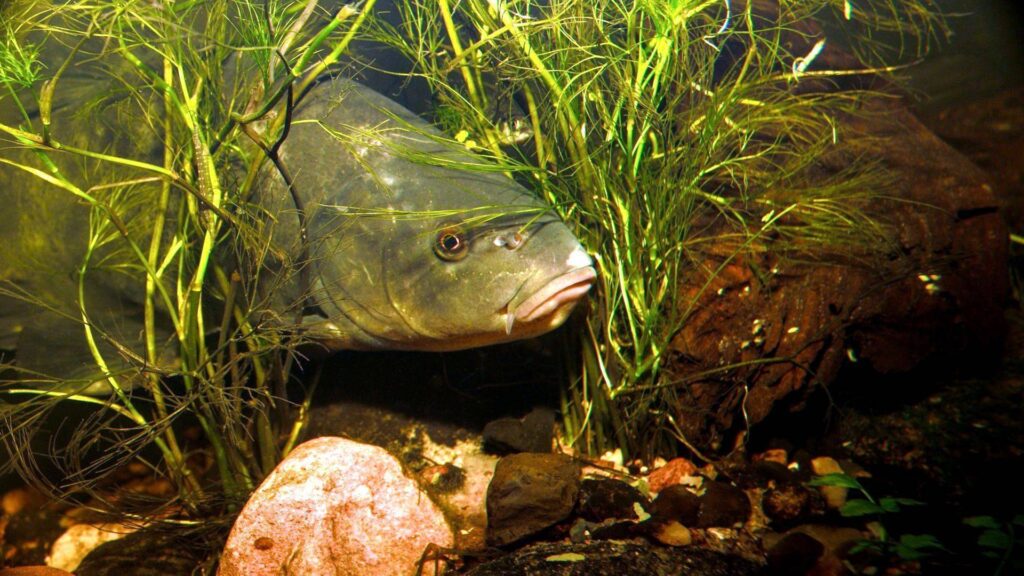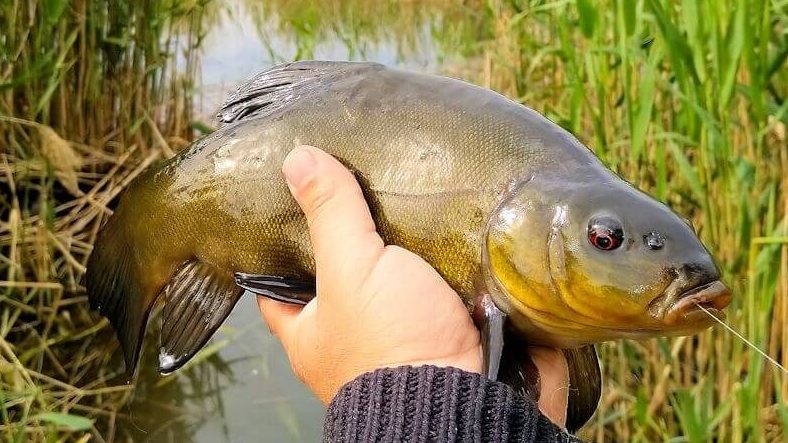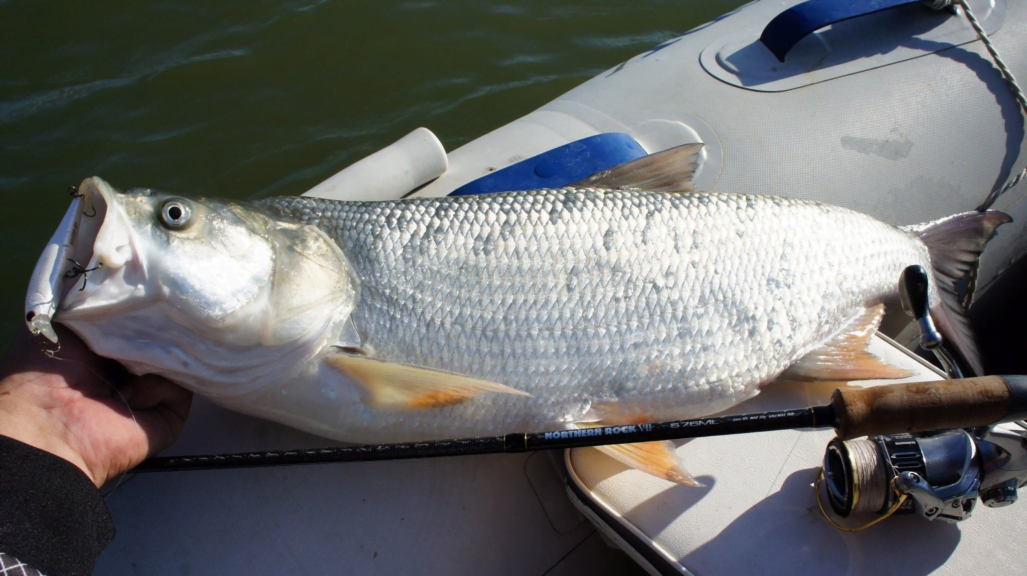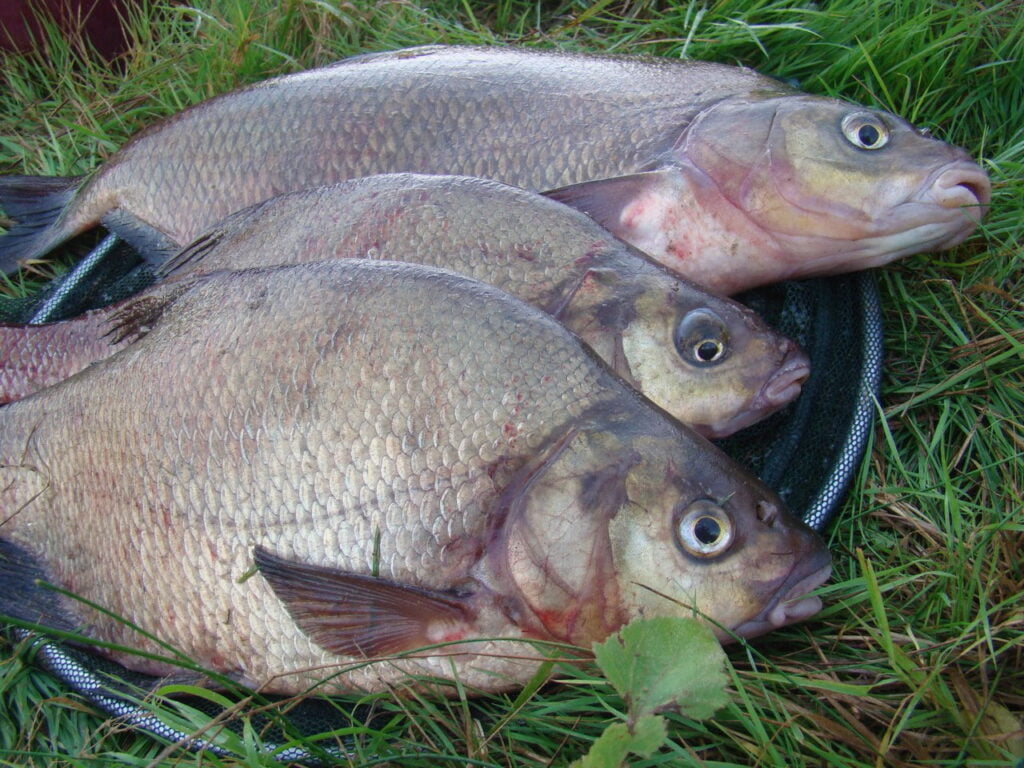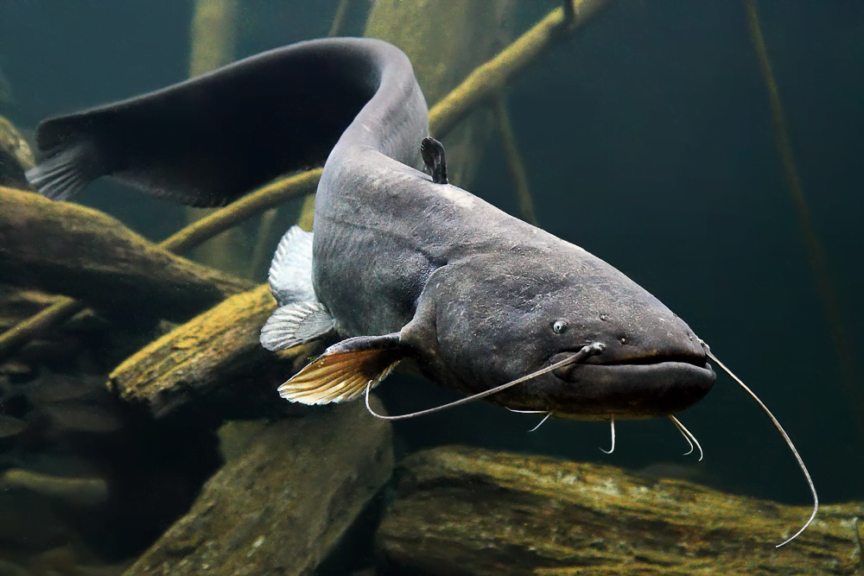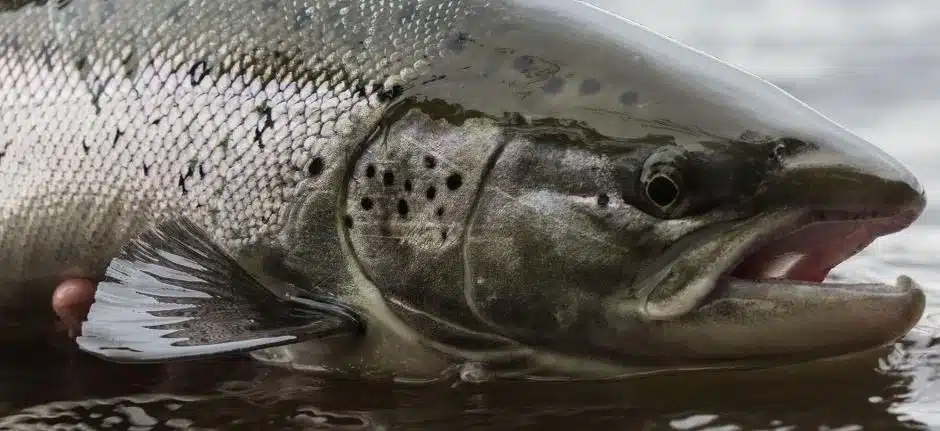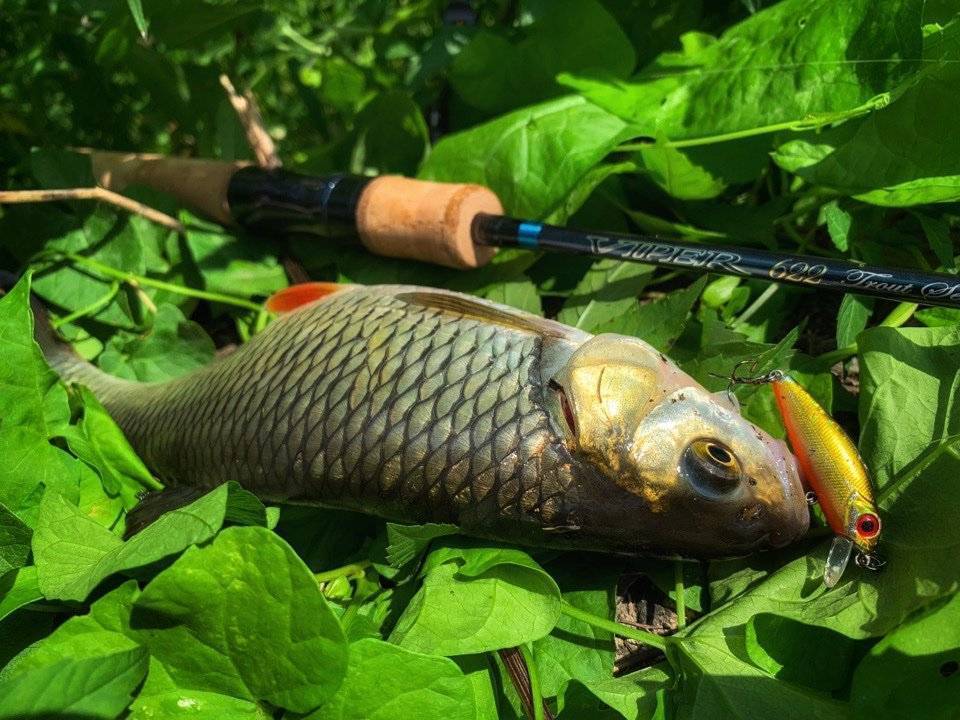Lynas panašus į karpines žuvis. Žuvies kūno spalva dažnai keičia atspalvius priklausomai nuo vandens telkinio. Smėlėtame ežere yra žuvų su sidabro-alyvuogių ir bronzos atspalviu. Taip pat yra tamsiai žalių, beveik juodų, gyvenančių stipriai uždumblėjusiuose ir durpinguose prūduose. Išskirtinis lynų bruožas yra mažos ryškiai raudonos akys, maža burna storomis lūpomis. Kūnas padengtas smulkiais, gleivėtais žvyneliais. Lyno beveik neįmanoma supainioti su kitomis žuvimis, nes panašių žuvų praktiškai nėra.
Kur gyvena lynas
Lynas – žuvis, kuri mėgsta ramias upių įlankas, apaugusias augmenija. Lynas patogiai jaučiasi dideliuose tvenkiniuose ir ežeruose, gyvena pakrantėse, apaugusiuose nendrėmis, lelijomis ir žolėmis.
Vasarą lynai mėgsta seklius vandens plotus, saulės gerai įkaitintuose krūmynuose su dumblinu dugnu, kur gylis siekia iki 2-3 metrų. Jie nemigruoja po vandens telkinį. Maistą ieško rausdami dumblą. Kad lynas atplaukė maitintis galima suprasti kai pradeda kilti daug mažų burbuliukų į vandens paviršių. Tai reiškia, kad lynas aktyviai rausią dumblą ir ieško maisto.
Nepaisant to, kad vidutiniai ir dideli individai gyvena atskirai, jaunos ir mažos žuvys susirenka į mažus būrius. Artėjant šaltiems orams, rudeniui, lynai nustoja maitintis, telkiasi į pulkus ir, arčiau lapkričio pradžios, pradeda žiemoti.
ĮDOMUS FAKTAS
Žiema laikoma pavojingu laiku lynams, nes smarkiai sumažėjus vandens lygiui gali žūti žuvys, sekliame vandenyje jas gali prispausti ledas. Lynus nuo šalčio gelbsti ant žvynų esančios gleivės – tai savotiška apsauginė kapsulė.
Lynas yra vieniša žuvis, vedanti sėslų gyvenimo būdą. Vengia ryškios šviesos ir slepiasi žolėse. Lynai nereikalauja didelio deguonies kiekio vandenyje, todėl gali išgyventi ten, kur negali kitos žuvys.
Sezoninis aktyvumas
Didžiausias aktyvumas stebimas ryte ir vakare – dažniausiai šiuo laikotarpiu lynas atplaukią arčiau kranto. Likusį laiką žuvis praleidžia giliose vietose, tačiau ten ir toliau maitinasi. Pastebima, kad debesuotomis dienomis lynai gali maitintis visą dieną.
Pavasarį ir vasarą lynai gyvena prie krantų apaugusių augalija, kur dugne daug dumblo. Gyvena saulės įkaitintose vietose 1-2 metrų gylyje. Nuolat gyvena vienoje vietoje.
Rudenį, atėjus šaltiems orams, nustoja maitintis ir žiemoja telkinių ir upių dumblo duobėse. Žiemą žuvų aktyvumas nepastebimas – jos žiemoja.
Žvejyba vyksta nuo pavasario iki rudens. Pavasarį, atšilus vandeniui, lynas artėja prie kranto linijos, nedidelių augmenijos ir dumblių plotelių, kuriuose ieško maisto.
Kuo minta lynas
Šių žuvų mitybos pagrindas yra gyvūninės kilmės maistas, nors kartais jos gali vartoti ir augalinį maistą. Medžioklės objektai – vandenyje ir prie vandens telkinių gyvenantys bestuburiai: vabzdžiai ir jų lervos, moliuskai, vėžiagyviai, kirmėlės. Pavasarį mielai minta dumbliais ir žolėmis.
ĮDOMUS FAKTAS
Žuvys neturi sezoniškumo, jos yra visiškai nepretenzingos mitybos požiūriu ir valgo viską, ką tik gali rasti.
Lynai maitinasi dugne, kuriose yra durpingo ar dumbluoto dirvožemio, ir povandeninių augalų krūmynuose. Norėdami gauti maisto, šios žuvys turi kasti dugną. Rudenį lynai minta mažiau nei vasarą, o žiemojimo metu visiškai nesimaitina.
Tačiau atėjus pavasariui, kai tampa šilta, lynai pabunda iš žiemos miego ir migruoja arčiau pakrantės ieškoti maistingo maisto. Jie minta žuvimis ir uodų lervomis.
Dauginimasis
Lynas yra laikomas termofiline žuvimi, galinčia neršti gana vėlai, dažniausiai vėlyvą pavasarį arba vasaros pradžioje. Kaip nerštavietę jie dažniausiai renkasi seklią vietą, apsaugotą nuo vėjo ir gausiai apaugusį vandens augalija. Ikrus deda 30-80 centimetrų gylyje ir dažnai tvirtinami prie šalia kranto augančių į vandenį nuleistų krūmų ar medžių šakų.
Nerštas vyksta kelis kartus su 10–14 dienų pertrauka. Neršto procese dalyvauja žuvys, pasiekusios brendimą, 3-4 metų amžiaus. Dauginasi tik tos žuvys, kurių svoris siekia ne mažiau kaip 200–400 gramų. Per vieną sezoną žuvys gali padėti apie 20-500 tūkstančių ikrų, kurie subręsta per tris dienas.
Mailiaus dydis neviršija 3,5 milimetro, lieka toje pačioje vietoje, kur gimė. Visą šį laiką lerva sparčiai auga, maitinasi trynio maišelyje likusiomis atsargomis.
Kai mailius tampa savarankiškas, jie susirenka į pulkus ir slepiasi tankioje povandeninėje augmenijoje, valgydami gyvūnų planktoną ir vienaląsčius dumblius, kad išgyventų. Vėliau, kai žuvies ilgis siekia apie 1,5 centimetro, jaunikliai keliauja į dugną, kur pradeda maitintis maistingesniu maistu.
Žvejyba
Lynai išrankūs masalams. Dėl šios priežasties lynų gaudymas gali atrodyti gana sudėtingas procesas. Tačiau žvejyba taps įdomiu procesu, jei žinosite apie žuvų įpročius konkrečiame ežere.
Vasara
Vasara – pats geriausias laikas lynų žvejybai. Šiuo laikotarpiu žuvys yra aktyvesnės. Atsižvelgiant į žuvies maisto pobūdį, ji gaudoma ant kelių tipų įrankių – plūdinės ir dugninės meškerės. Pirmasis metodas yra geras, nes jis rodo puikius gaudymo rezultatus. Kalbant apie dugninę meškerę, geriau teikti pirmenybę method feederiui, nes gaudoma dumblinuose vietose ir paprastos šeryklos tiesiog paskes dumble. Kaip vyksta žvejyba method feederiu galite paskaityti šiame mano straipsnyje.
Atviro vandens sezono pradžioje lynai minta gyvuliniu maistu, todėl kaip masalas naudojami sliekas, naktinis sliekas, dzykai. Linui patinka dėlės, kurios gyvena tvenkinyje. Kiek vėliau, pasirodžius augalams, žuvies valgiaraštis tampa įvairus ir galima pradėti naudoti įvairiausius boilius, kukurūzus ir t.t.
Geriausia žvejyba augaliniais masalais prasideda vasaros pabaigoje. Žvejai naudoja miežius, žirnius, kukurūzus. Žuvys neabejingos varškei. Kai kurie meškeriotojai pastebi, kad į kai kuriuos masalus įmaišius varškės, kibimas tampa daug geresnis.
Žiema
Nors žiemą lynai nėra labai aktyvūs, kai kuriuose vandenyse, kuriuose yra geras deguonies prisotinimas ir šiltesnis vanduo, lynas gali išeiti iš žiemos miego ir pradėti maitintis. Taip būna retai. Jei lynas žiemą užkibo ant kabliuko, tai laikoma tiesiog didele sėkme.
Lyno gaminimas
Yra keletas niuansų, kurie padės išsirinkti šviežią žuvį kepimui. Juk šviežų lyną galima laikyti ne ilgiau kaip 3 dienas, o prieš laikymą jį reikia išdarinėti. Virta žuvis laikoma daug ilgiau, ne aukštesnėje kaip +5 laipsnių temperatūroje. Bet vis dėlto, visų pirma, jį reikia nusipirkti turguje ar parduotuvėje arba pagauti savo rankomis. Jei lyną pagavote patys tai dėl žuvies šviežumo problemų nekils. Jei norite nusipirkti, turite ją atidžiai išnagrinėti.
- Žuvies akys turi atrodyti skaidrios.
- Įspauskitę žuvį pirštais. Jei po to lieka įdubimas, vadinasi, žuvis nešviežia.
Taip pat verta atkreipti dėmesį į naudingas lyno savybes. 100 gramų šios žuvies mėsos yra tik 40 kcal, todėl ji yra nepakeičiama kaip dietinis produktas. Mėsos sudėtyje yra daug naudingų komponentų, tokių kaip vitaminai, mineralai, aukštos kokybės baltymai. Dėl aukštos kokybės baltymų, turinčių nepakeičiamų amino rūgščių, gydytojai pataria valgyti šią žuvį reguliariai.
